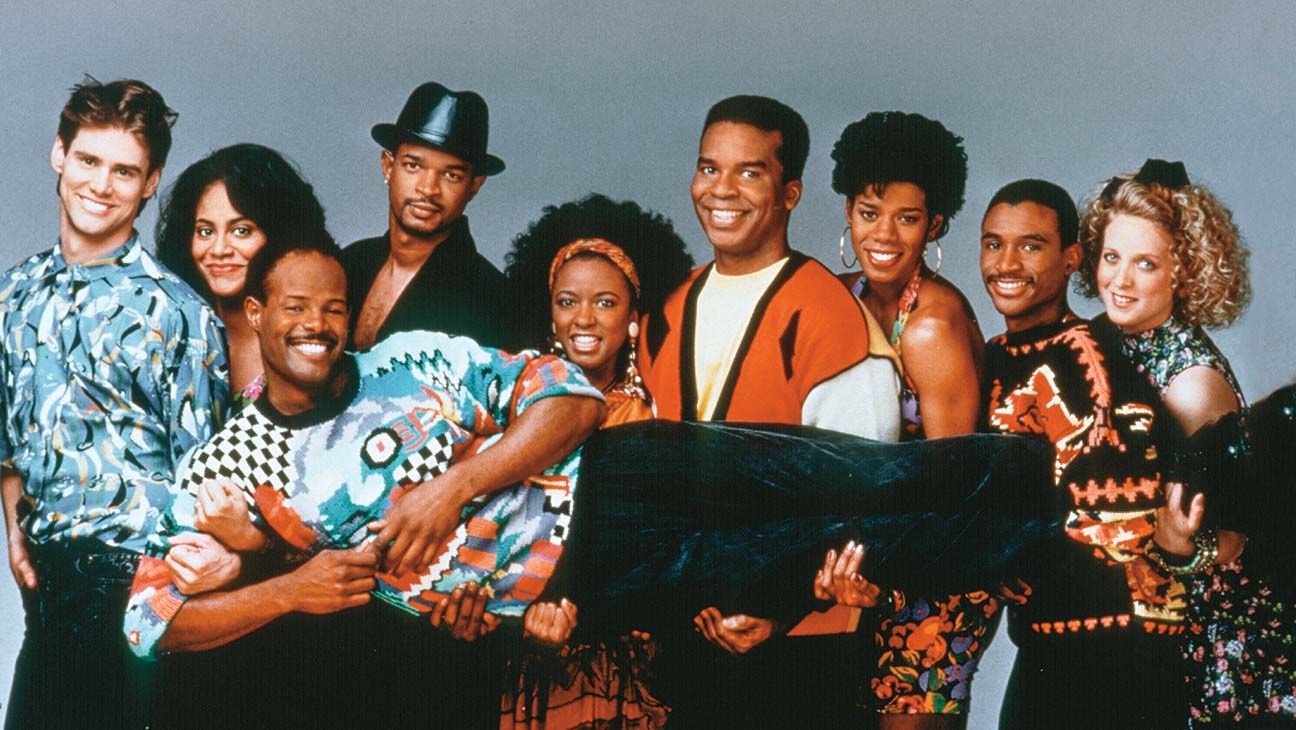From a $10M Check to Reality: Jim Carrey’s Law-of-Attraction Playbook (No Magic Wand)
In the 1990s, Jim Carrey told Oprah he had written himself a $10,000,000 check for “acting services rendered,” dated Thanksgiving 1995, and kept it in his wallet as a daily target. He’d drive up to Mulholland Drive, visualize success, and keep working. He later said he placed that worn check in his father’s casket when his dad died—because it had been their shared dream.
The Wayans Launchpad: From Sketch TV to a Breakout Run

Before the $10M era, Jim Carrey’s momentum got a crucial boost with the Wayans family. He spent four seasons on In Living Color (1990–1994), the hit sketch series created by Keenen Ivory Wayans, where weekly characters (like Fire Marshal Bill) gave him national visibility and relentless on-camera reps. A few years earlier, he and Damon Wayans had already shared the screen in Earth Girls Are Easy (1988), alongside Geena Davis and Jeff Goldblum—an early collaboration that helped seed relationships and open doors.
Takeaway: Relationships + reps accelerate results. Find rooms that sharpen your skills and put you in front of the right people consistently; compounding starts there.
The true story: the check, the movies, the paydays
1994 was the explosion: Ace Ventura: Pet Detective, The Mask, and Dumb and Dumber all hit the same year. Reported pay jumped from mid–six figures on Ace Ventura and The Mask to $7M on Dumb and Dumber; then ~$5M for Batman Forever (1995) and $20M for The Cable Guy (1996).
- When he wrote the check: Accounts differ on the precise year. A New Yorker profile reports Carrey wrote the check in 1990 and post-dated it to Thanksgiving 1995. On Oprah, he emphasized the date and the ritual of visualizing on Mulholland Drive.
- ’95–’96 pay scale: Carrey reportedly earned $5,000,000 for Batman Forever (1995) and then broke the bank at $20,000,000 for The Cable Guy (1996)—establishing the $10M+ tier he’d aimed at.
- About the “$10M on Dumb and Dumber” line: Carrey recalled learning he’d be making $10M right before Thanksgiving 1995; however, contemporaneous figures widely cited for Dumb and Dumber put his pay at $7M while co-star Jeff Daniels earned $50K. Either way, by the following year Carrey was a $20M actor.
Bottom line: The check wasn’t superstition—it was a clear target that aligned his choices (training, output, risk) until the market and his skill caught up.
1) The $10M check: what actually matters
Carrey’s check worked as focus tech. A number, a date, a lane (“acting services rendered”). It kept his day-to-day aimed at the outcome.
Do this (5 minutes):
- Write one measurable outcome: “Earn $150,000 from design services by Dec 31, 2026.”
- Put it where you’ll see it daily (wallet, mirror, lock screen).
2) Clarity beats vibes: pick a number, date, and vehicle
Vague goals → vague actions. Specifics drive specific reps.
Build your target
- Number: the exact amount/outcome
- Date: ambitious but feasible
- Vehicle: the lane that earns it (role, offer, business model)
Add milestones (e.g., $60k → $90k → $120k) so progress is trackable.
3) Emotion is the magnet—behavior is the engine
Visualization lands when you feel it: not just wanting money, but picturing the work and life attached—scripts, clients, drafts, reps.
Daily 3-minute protocol
1. See it: the proof moment (contract signed, wire received).
2. Feel it: relief, pride, gratitude.
3. Act: one concrete step (send the pitch, tape the scene, make the call).
4) Make your “check” a system, not a souvenir
A target without a system is a wish. The check should trigger training, output, and pipeline—every week.
Weekly system (copy/paste)
- Skill blocks (2–5 hrs): coaching, drills, deliberate practice
- Output (3–10 units): auditions, pitches, content, iterations
- Pipeline (daily): outreach, follow-ups, applications, collabs
- Review (30 min): keep only what produced replies/sales
If it’s not on the calendar, it’s not real.
5) Train for the role you want
Carrey’s run came after years of reps—stand-up, sketch, scene study, writing. Manifestation didn’t replace training; it aimed it.
Upgrade your lane
- Pick two skills that would move revenue/bookings fastest.
- Buy speed with a coach or a feedback loop.
- Publish evidence (reels, case studies, demos) to build trust.
6) Doubt happens. Build guardrails.
Big targets trigger resistance. Guardrails keep you moving when motivation dips.
- Floor routine: on low days, do the smallest viable step (one email, one page, one set).
- No-zero days: track streaks; momentum beats intensity.
- Environment cues: place the “check” where decisions happen.
- Accountability: weekly check-in (wins, numbers, next actions).
7) Write your own check (practical anchors)
Classic check:
“Pay to the order of [Your Name] — $[Amount] — For [Service/Lane] — [Date].”
Or use these anchors:
- Mock invoice/contract with your rate and client type
- Mock wire confirmation with a realistic memo line
- Mock offer letter with title, salary, and start date
Put it where you can’t ignore it.
8) Action > magic: a 90-day sprint
- Days 1–7: Define number/date/vehicle. Build a simple offer or 60-sec reel. Ship first 10 outreaches.
- Days 8–30: Daily pipeline (5–10 outreaches), two portfolio pieces/reels, start one class.
- Days 31–60: Double what produced replies; refine positioning; add one collaboration.
- Days 61–90: Make a bigger ask (raise rates, larger client, higher-tier audition). Weekly review—keep only what moves.
Track three metrics
- Inputs: reps (auditions/pitches/posts)
- Signals: opens, replies, callbacks, meetings
- Wins: bookings, contracts, deposits
9) What manifestation can’t do (and what it can)
It won’t bypass practice or market math. It will keep your brain locked on target, your emotions aligned with effort, and your calendar stacked with the right actions—long enough for compounding to hit.
Translation: The check in your wallet is a promise to do what most won’t—for longer than they will.
10) Start now (2 minutes)
- Write the check (or mock invoice).
- Place it where you’ll see it.
- Take one aligned action today.
Sources for the Jim Carrey story (for the curious)
- Oprah’s Lifeclass clip referencing the $10M check and visualization routine.
- The New Yorker profile noting the check was written in 1990, post-dated to Thanksgiving 1995.
- Carrey’s on-air quote about the $10M check and placing it in his father’s casket.
- Documented salaries: $350k (Ace Ventura), $540k (The Mask), $7M (Dumb and Dumber), $5M (Batman Forever), $20M (The Cable Guy).
- Snopes fact-check confirming $7M for Dumb and Dumber and Jeff Daniels’ $50K.
🧠 ThinkwithAD – PULSE
Real-world playbooks for growth—money, mindset, and moves that actually land. Urban lens, professional execution. No BS, just strategy.

⚠️ Disclaimer: For educational and motivational purposes only—not financial, legal, or career advice. Outcomes vary; examples (including Jim Carrey’s story) are illustrative, not promises of results. No affiliation with Jim Carrey or any film studio; references are used for commentary.